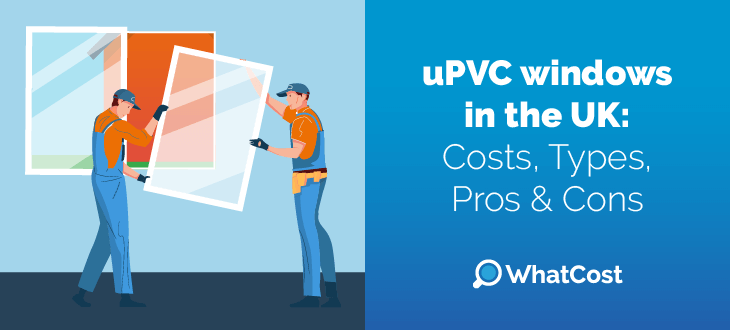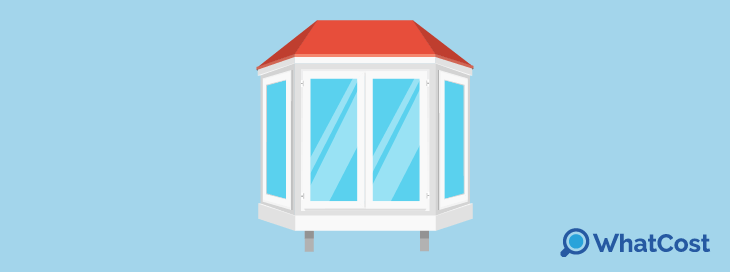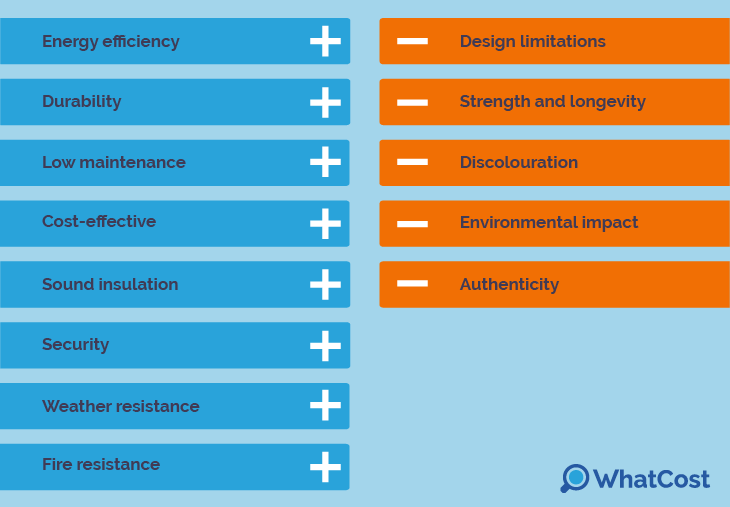Answer these simple questions and we will find you the BEST prices
Which type of solar quotes do you need?
It only takes 30 seconds
100% free with no obligation

Get up to 4 quotes by filling in only 1 quick form

Compare quotes and find yourself the best deal

Increase the value of your home by installing new windows
- whatcost.co.uk
- Windows
- uPVC Windows
uPVC windows in the UK: Costs, Types, Pros & Cons (2025)


- The typical price for uPVC windows in the UK ranges from £160 to £1,240 per window, depending on style, size, colour, and glazing. For a standard three-bedroom house, the average cost for a full set of eight windows is about £3,800.
- Popular styles include casement, sash, sliding, tilt-and-turn, and bay windows. Each style offers unique aesthetics and functionality, with options for double or triple glazing, and a variety of colours and finishes to suit any property.
- uPVC windows are renowned for their excellent thermal efficiency, reducing energy bills and keeping your home comfortable all year round. They also require very little maintenance and are highly resistant to weather and rot.
uPVC windows have become the leading choice for homeowners across the UK. They are made from unplasticised polyvinyl chloride and are valued for their durability, energy efficiency, and low maintenance requirements. On this page, we’ll cover everything you need to know about uPVC windows: their costs, the main types available, and the key pros and cons to help you decide if they’re right for your home.
While our guide equips you with valuable knowledge you’re probably still wondering how you can find trustworthy uPVC window installers without taking up hours of your free time.
Thankfully, we also offer a convenient solution – a free, no-obligation service connecting you with up to 4 qualified installers near you. This service ensures you receive tailored advice and save valuable time and money by comparing different options. Click below to get started.
- Quotes from local installers
- Payment by finance available
- Save up to £150 per year
It only takes 30 seconds

What are uPVC windows?

uPVC windows are made from un-plasticised polyvinyl chloride, a strong and rigid type of plastic widely used for window frames in the UK since the 1980s. uPVC is usually 20-30% cheaper than aluminium and significantly less expensive than timber, making it a cost-effective option for most homeowners.
Unlike traditional PVC, uPVC does not contain plasticisers, which makes it more robust and less flexible. This material is highly resistant to weather, rot, and corrosion, ensuring the windows remain in good condition for decades with minimal maintenance.
These windows are designed with multiple internal chambers in the frame, which trap air and provide excellent insulation. This helps to keep your home warmer in winter and cooler in summer, reducing energy bills and improving comfort.
In summary, uPVC windows are a popular choice for UK homeowners due to their durability, energy efficiency, and low upkeep. They offer a practical and cost-effective way to improve your home’s comfort, security, and appearance.
Types of uPVC windows
uPVC windows come in a variety of styles to suit different homes, tastes, and practical needs. Each type offers its own advantages, from classic charm, modern functionality, or extra space and light. Understanding these main types will help you choose the best fit for your property. Here are the types of uPVC windows you can purchase in the UK:
Casement windows

The most common style in the UK, casement windows are hinged at the side and swing outwards like a door. They provide excellent ventilation and unobstructed views, and their airtight seals make them highly energy efficient. Casement windows are versatile and suit both modern and traditional homes.
Sliding sash windows

These windows have one or more panels (sashes) that slide vertically to open. Sash windows are a staple of Georgian and Victorian architecture, but are now available in modern uPVC for improved insulation and security. They’re perfect for adding period character to your home.
Horizontal sliding windows

Similar to sliding patio doors, these windows open by sliding along a horizontal track. They’re great for spaces where outward-opening windows aren’t practical and allow you to control the amount of ventilation easily.
Tilt-and-turn windows

This style can open in two ways: tilt inwards at the top for gentle ventilation, or swing fully open from the side for easy cleaning and maximum airflow. Tilt-and-turn windows are popular in modern homes and are especially useful for upper floors or where safety is a concern.
Bay windows

Bay windows project outwards from the wall, creating a semi-circular or angled extension. This design increases the amount of natural light in a room and adds extra space, often used for a window seat or decorative feature. They work well in both older period properties and newer contemporary homes. Although the average bay window price can be a bit hefty, they provide great lighting and ventilation.
Each type of uPVC window has unique benefits, so your choice will depend on your home’s style, your budget, and your personal preferences.
How much do uPVC windows cost?
The average price for uPVC windows in the UK ranges from £160 to £1,240 per window and fitting a full set of eight uPVC windows in a typical three-bedroom UK home costs around £3,800 including installation. New window cost varies depending on the style, size, glazing type, colour, and whether installation is included. Generally, uPVC windows offer excellent value for money, combining affordability with good energy efficiency and durability.
Here’s a table showing typical price ranges for common uPVC window styles:
| Type of uPVC Window | Price Per Window (Inc. VAT) |
|---|---|
| Casement | £160 - £825 |
| Sash | £240 - £1,240 |
| Sliding | £200 - £1,200 |
| Tilt and Turn | £200 - £1,030 |
| Bay | £1,190 - £1,800 |
Several factors affect the final cost of uPVC windows:
- Window style and size: Larger or more complex styles, such as bay and sash windows, require more materials and labour, making them more expensive.
- Type of glazing: Secondary glazing adds an extra pane to existing windows, and it usually costs around £400 per window. Double glazing is the most common and cost-effective choice, as reflected in the prices above. Triple glazing offers better insulation and noise reduction, but is almost 30-50% more expensive than double glazing. The cost of triple glazing windows is around £1,200 per window.
- Frame colour and finish: Choosing coloured or wood-effect frames usually adds 10-25% to the cost compared to standard white frames.
- Installation charges: Labour costs can vary by region and depend on the complexity of the fitting required.
- Additional features: Extras such as decorative glazing bars, custom hardware, or integrated blinds can increase the overall price.
These factors combine to determine the total price you’ll pay for your new uPVC windows.
To get the correct and best price for your home rather than an estimate, you do need to compare multiple quotes and talk to a professional window installer. While finding one can be a laborious task that takes days of calling up companies and collecting prices all on your own, it doesn’t have to be. Just fill our 30-second form and we can quickly and easily provide you with online window quotes from up to 4 certified window installers in your area.
- Quotes from local installers
- Payment by finance available
- Save up to £150 per year
It only takes 30 seconds

Replacement uPVC windows

Over time, many homeowners in the UK are not just replacing old uPVC windows, but also upgrading from timber or metal frames to uPVC. In fact, uPVC now accounts for about 90% of the replacement window market in the UK. Knowing when and how to replace them ensures your property stays warm, quiet, and secure.
When considering the replacement of your uPVC windows, you have the option to buy windows that are made to fit your exact window openings. This can either just be the windows if you want to install them yourself, or come with professional installation included. Many suppliers offer online ordering, with prices starting from as little as £65 per window for supply-only options.
Before ordering, it’s crucial to measure your existing window openings accurately to ensure a perfect fit. If you’re not confident with DIY, professional installers can handle the entire process, from removing old windows to fitting the new ones securely.
When choosing new uPVC windows, focus on energy efficiency, security, and design. Look for windows with a U-value of 1.4W/m²K or lower, as required by UK building regulations. U-value measures how well a window insulates your home.
Signs you need to replace your uPVC windows
There are several clear indicators that your uPVC windows may need replacing. Here is a list of a few of them to keep an eye out for:
- Draughts, leaks, or condensation between panes, which is a sign of failing seals or glazing.
- Difficulty opening, closing, or locking the windows, often due to warped frames or worn-out hardware.
- Noticeable damage, such as cracks, chips, or fading, on the frames.
- Increased energy bills or cold spots near windows, showing poor insulation.
- Excessive noise from outside, indicating reduced soundproofing.
- Windows are single-glazed or have outdated double glazing.
If you notice several of these issues, it’s usually more economical and effective to replace the windows rather than attempt repairs. Replacement of your uPVC windows will not only resolve these problems but also boost your home’s curb appeal and value.
Advantages & disadvantages of uPVC windows

uPVC windows are a popular choice for UK homeowners because they offer a blend of affordability, energy efficiency, and low maintenance. However, as with any material, there are both benefits and drawbacks to consider before making your decision. Here is a clear overview to help you weigh up whether uPVC windows are right for your home.
- Energy efficiency: Highly energy efficient as it has A+ to A++ energy ratings and U-values as low as 1.0 W/m²K for triple glazing. This helps to keep your home warm while reducing heating bills.
- Durability: uPVC frames resist warping, rotting, and corrosion, and typically last 20-25 years.
- Low maintenance: It requires only an occasional wipe down with soapy water - no repainting or varnishing needed.
- Cost-effective: It is more affordable than timber or aluminium frames, making them a budget-friendly upgrade.
- Sound insulation: It provides good noise reduction, making your home quieter.
- Security: uPVC windows are often reinforced with steel and fitted with multi-point locking systems for improved safety.
- Weather resistance: It withstands harsh weather conditions, including coastal salt air.
- Fire resistance: It can maintain its shape in fire, helping by providing a safe escape route.
- Design limitations: It has limited colour and style options compared to timber or aluminium options, which may not suit older or heritage homes.
- Strength and longevity: uPVC windows are not as strong or long-lasting as aluminium or high-quality timber. uPVC frames can sag or crack over time, especially in extreme weather conditions.
- Discolouration: It can go yellow or discolour after many years, particularly when exposed to strong sunlight.
- Environmental impact: It is made from plastic, which is less eco-friendly than timber. Although it is recyclable, manufacturing it has a higher environmental footprint.
- Authenticity: It may not provide the authentic look needed for traditional or listed buildings.
By understanding these pros and cons, you can make an informed choice about whether uPVC windows are the best fit for your property and your needs.
Are uPVC windows the right choice for you?
Choosing the right windows for your home is a big decision, and uPVC windows continue to stand out as a top option for UK homeowners. Their popularity comes from a blend of energy efficiency, durability, and affordability, making them a practical investment for both modern and traditional properties.
uPVC windows offer excellent insulation, helping to keep your home warm in winter and cool in summer, which can lead to significant savings on your energy bills. They’re also low-maintenance, requiring just an occasional wipe to stay looking their best, and are built to last for decades without warping, rotting, or fading. Added security features and a wide choice of styles and finishes mean you don’t have to compromise on safety or aesthetics.
If you’re looking for windows that combine cost-effectiveness, long-term performance, and a boost to your home’s value, uPVC is a wise choice.
Want to get a uPVC window, but don’t know where to start?
We can find you up to 4 free quotes from installers in your area. Avoid the hassle of spending days on research and comparisons on your own.
Fill in our 30-second form and we’ll do the rest.
- Quotes from local installers
- Payment by finance available
- Save up to £150 per year
It only takes 30 seconds

FAQ
The average cost for uPVC windows in the UK ranges from £160 to £1,240 per window. This depends on the style, size, colour, and glazing you choose. For a standard three-bedroom house, the average cost for a full set of eight windows is about £3,800.
uPVC windows typically last around 20 to 25 years, although this can vary between 10 and 35 years depending on the quality of the materials, installation, and how well they are maintained.
Yes, replacing old uPVC windows is often worthwhile if they are inefficient, damaged, or showing signs like condensation inside the panes, difficulty opening or closing, or increased energy bills. Newer uPVC windows offer better insulation, improved security, and can enhance your home’s appearance and value.
While it is possible to replace uPVC windows yourself, it is generally recommended to hire a professional. Incorrect installation can lead to water damage, poor insulation, and security issues. Professionals have the experience and tools to ensure a safe, secure, and properly sealed fit, avoiding costly problems later.

Swathi’s journey in the field of content creation began with her education in journalism, where she developed a deep understanding of the power of words and the importance of effective communication.
